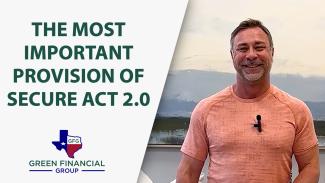
Secure Act 2.0 Is Giving People More Control Over Their Retirement Savings
How the new Secure Act 2.0 is changing required minimum distributions.
Secure Act 2.0 has been introduced, and it's set to replace its predecessor, Secure Act 1.0, which was released in 2020. This new Act has various provisions, but the one that stands out to me as the most important is the new age limit on required minimum distribution (RMD).
For those who may not know, RMD is the minimum amount that a person with a qualified retirement account must withdraw each year once they reach a particular age. The age limit was set at 70 and a half, but Secure Act 1.0 raised it to 72. Now, with Secure Act 2.0, the age limit has been raised yet again, from 72 to 73. So, if you turn 72 in 2023, you won't have to take your RMD until you turn 73.
“This increase to the RMD age is a game-changer for folks who may want more time to prepare financially.”
This provision is a significant change because it affects almost everyone with a qualified retirement account. This means people can delay taking their RMD for an additional year, which could be a game-changer for those who may not need their RMD immediately and can take advantage of the extra time to allow their money to grow.
Furthermore, it's worth noting that Secure Act 2.0 will increase the age limit on RMD to 75 in 2033. This is good news for individuals who may not have started saving for retirement yet or who want to continue to save for an extended period.
While there are other provisions in Secure Act 2.0 that may be relevant to specific individuals, this change to the RMD age limit is the one that will impact almost everyone. It's a positive development that gives individuals more flexibility and control over their retirement savings.
If you have any questions about the Secure Act, don't hesitate to reach out to me by phone or email for more information.
The information contained in this blog does not purport to be a complete description of the securities, markets, or developments referred to in this material. The information has been obtained from sources considered to be reliable, but we do not guarantee that the foregoing material is accurate or complete. Any opinions are those of the author, and not necessarily those of Raymond James. Expressions of opinion are as of this date and are subject to change without notice. There is no guarantee that these statements, opinions, or forecasts provided herein will prove to be correct.
Every investor's situation is unique and you should consider your investment goals, risk tolerance, and time horizon before making any investment. Investing involves risk and you may incur a profit or loss regardless of the strategy selected. The foregoing is not a recommendation to buy or sell any individual security or any combination of securities. Be sure to contact a qualified professional regarding your particular situation before making any investment or withdrawal decision.
